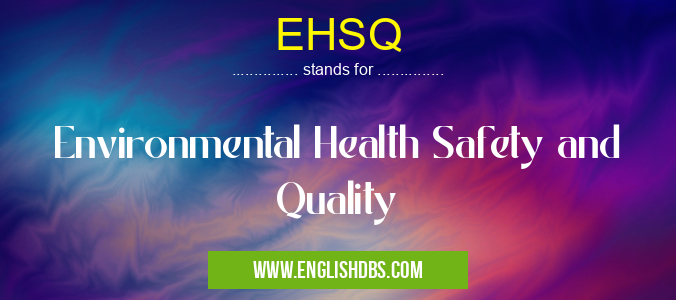What does EHSQ mean in HEALTHCARE
Environmental Health Safety and Quality (EHSQ) is a collective term used to describe the management of environmental, health, safety and quality aspects associated with operating a business. It focuses on minimizing the risks and impacts resulting from an organization’s activities. In addition, EHSQ involves planning ahead, developing strategies to reduce environmental hazards, improving workplace safety standards and managing resources efficiently to support the long-term sustainability of the enterprise.

EHSQ meaning in Healthcare in Medical
EHSQ mostly used in an acronym Healthcare in Category Medical that means Environmental Health Safety and Quality
Shorthand: EHSQ,
Full Form: Environmental Health Safety and Quality
For more information of "Environmental Health Safety and Quality", see the section below.
» Medical » Healthcare
Essential Questions and Answers on Environmental Health Safety and Quality in "MEDICAL»HEALTHCARE"
What are the primary responsibilities of an EHSQ professional?
An EHSQ professional is primarily responsible for developing, implementing and monitoring strategies to safeguard workers, the public and ecosystems from potential hazards. This includes assessing potential risks, ensuring compliance with applicable laws and regulations, designing precautionary measures and training employees on safety protocols.
What does a typical day look like for an EHSQ professional?
A typical day for an EHSQ professional might include meeting with staff to discuss recent developments in safety law and regulations, evaluating workplace hazards, inspecting the facility to identify any unsafe conditions or hazardous materials, creating or updating safety policies and procedures, developing training materials and delivering health and safety presentations.
How important is it to have a comprehensive understanding of regulations when practicing in the EHSQ field?
It is absolutely essential that EHS professionals understand applicable laws and regulations in order to ensure compliance and protect workers from avoidable harm. Knowing how local, state or federal laws affect the company’s operations is key to success in this field. Additionally, understanding regulatory standards helps frame discussions with manufacturing partners about product safety requirements.
Is being up-to-date on regulatory changes always necessary for performing successful work as an EHSQ professional?
Yes, staying informed on legislative changes related to environmental health safety and quality standards is critical if you are going to be successful as an EHSQ professional. Regulatory changes can impact policy development–so having a knowledge of current trends will ensure that all protocols remain compliant with industry- specific requirements.
What role does communication play in protecting worker safety within the context of an organization's environmental health practices?
Communication plays an essential role in protecting worker safety by helping everyone understand their roles–from managers down to line operators–in helping maintain safe practices at all times. Education combined with effective communication can help reduce instances of noncompliance which could potentially lead to serious injury or harm if not addressed properly.
How does a comprehensive emergency response plan help organizations remain compliant with environmental health standards?
An emergency response plan serves as both a preventative measure against potential disasters but also as guidance that organizations must follow should such incidents occur. Having detailed instructions on how to react swiftly and efficiently will ensure companies not only meet environmental health standards but also help protect individuals who may be affected by such events.
What type of measures should companies take when introducing new chemicals into their operations?
When introducing new chemicals into operations it is important that companies take adequate measures to minimize exposure risks among workers while still maintaining efficiency levels expected within the organization’s production process. This could entail extra steps such as hazard assessment tests or outfitting workers with protective equipment before handling such materials directly.
How does OSHA fit into a company's efforts towards achieving compliance with environmental health laws?
OSHA (Occupational Safety & Health Administration) sets forth guidelines used by many organizations when attempting to comply with statutory requirements related to worker protection from adverse environments within the workplace context. Companies must adhere closely state these standards in order to successfully undergo audits which verify whether they are indeed meeting these obligations or not.
Can proper waste management help reduce potential risks for workers dealing with hazardous materials?
Absolutely! Managing waste correctly–whether chemical containers are identified properly labelled - can greatly reduce risk associated with contact with hazardous material exposure due its toxicity levels; proper segregation stored away from living/working spaces will further limit personnel hazards significantly.
